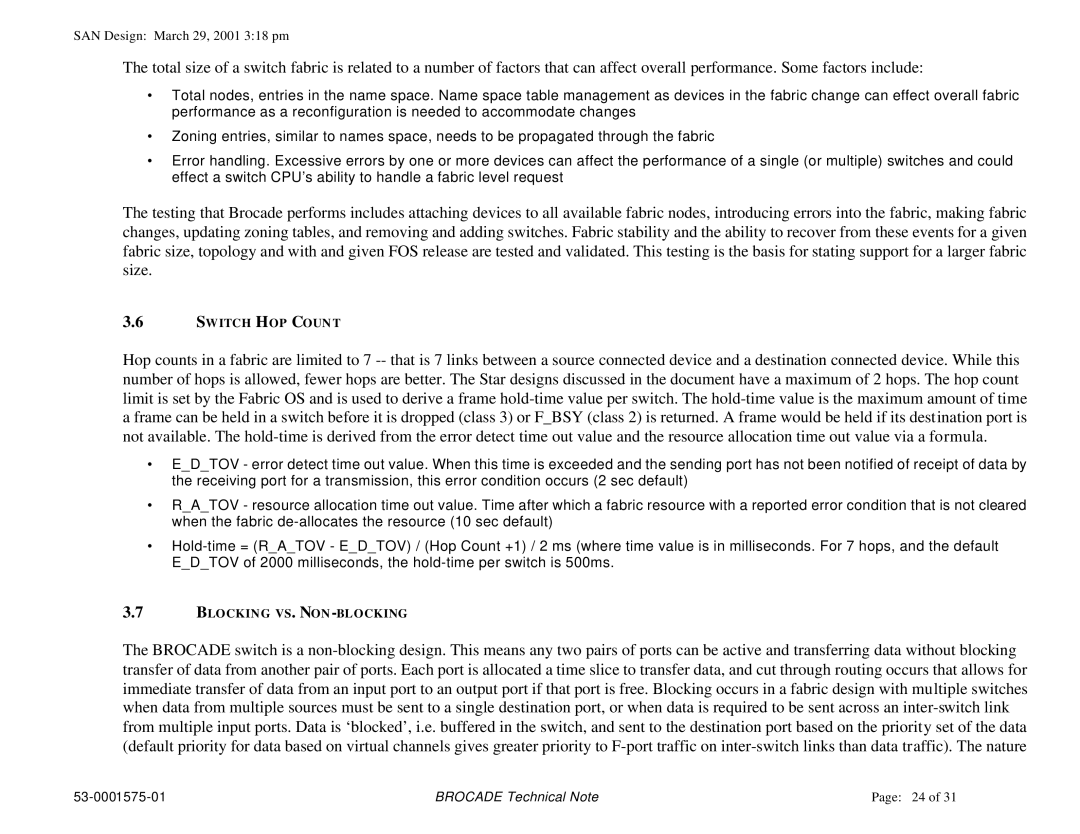SAN Design: March 29, 2001 3:18 pm
The total size of a switch fabric is related to a number of factors that can affect overall performance. Some factors include:
•Total nodes, entries in the name space. Name space table management as devices in the fabric change can effect overall fabric performance as a reconfiguration is needed to accommodate changes
•Zoning entries, similar to names space, needs to be propagated through the fabric
•Error handling. Excessive errors by one or more devices can affect the performance of a single (or multiple) switches and could effect a switch CPU’s ability to handle a fabric level request
The testing that Brocade performs includes attaching devices to all available fabric nodes, introducing errors into the fabric, making fabric changes, updating zoning tables, and removing and adding switches. Fabric stability and the ability to recover from these events for a given fabric size, topology and with and given FOS release are tested and validated. This testing is the basis for stating support for a larger fabric size.
3.6SWITCH HOP COUN T
Hop counts in a fabric are limited to 7 -- that is 7 links between a source connected device and a destination connected device. While this number of hops is allowed, fewer hops are better. The Star designs discussed in the document have a maximum of 2 hops. The hop count limit is set by the Fabric OS and is used to derive a frame hold-time value per switch. The hold-time value is the maximum amount of time a frame can be held in a switch before it is dropped (class 3) or F_BSY (class 2) is returned. A frame would be held if its destination port is not available. The hold-time is derived from the error detect time out value and the resource allocation time out value via a formula.
•E_D_TOV - error detect time out value. When this time is exceeded and the sending port has not been notified of receipt of data by the receiving port for a transmission, this error condition occurs (2 sec default)
•R_A_TOV - resource allocation time out value. Time after which a fabric resource with a reported error condition that is not cleared when the fabric de-allocates the resource (10 sec default)
•Hold-time = (R_A_TOV - E_D_TOV) / (Hop Count +1) / 2 ms (where time value is in milliseconds. For 7 hops, and the default E_D_TOV of 2000 milliseconds, the hold-time per switch is 500ms.
3.7BLOCKIN G VS. NON -BLOCKING
The BROCADE switch is a non-blocking design. This means any two pairs of ports can be active and transferring data without blocking transfer of data from another pair of ports. Each port is allocated a time slice to transfer data, and cut through routing occurs that allows for immediate transfer of data from an input port to an output port if that port is free. Blocking occurs in a fabric design with multiple switches when data from multiple sources must be sent to a single destination port, or when data is required to be sent across an inter-switch link from multiple input ports. Data is ‘blocked’, i.e. buffered in the switch, and sent to the destination port based on the priority set of the data (default priority for data based on virtual channels gives greater priority to F-port traffic on inter-switch links than data traffic). The nature
